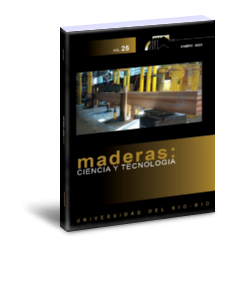Effects of glue spreading rate and veneer density on sugi (Cryptomeria japonica) plywood adhesive penetration
DOI:
https://doi.org/10.4067/s0718-221x2023000100408Keywords:
Adhesive penetration, phenol-formaldehyde, spreading rate, veneer density, X-ray densitometryAbstract
An optimum adhesive penetration is needed to provide satisfactory bonding strength at the veneer–veneer interface. The effect of veneer density and glue spreading rate on the phenol formaldehyde adhesive penetration plot profile was determined. An X-ray apparatus was used to visualize the adhesive penetration of the plywood. The heartwood and sapwood veneer of Cryptomeria japonica with low, medium, and high veneer densities were made into plywood. The glue spreading rate was applied from 75 g/m2 to 225 g/m2 for the heartwood plywood and up to 300 g/m2 for the sapwood plywood (plus 75 g/m2 at every level of glue spreading rate). An X-ray apparatus with a low tube voltage successfully visualized the adhesive penetration plot profile. Based on the half-width calculation, the adhesive penetration depth ranged from 0,3 – 0,9 mm. The mean half-width was 0,5 mm. The adhesive concentration increased with increasing glue spreading rate. In contrast, it also showed that using different veneer densities and increasing glue spreading rates does not affect the half-width value as the adhesive penetrates deeper.
Downloads
References
Asif M. 2009. Sustainability of timber, wood and bamboo in construction. Chapter 2: 31-54. In: Sustainability of construction materials. Khatib JM (ed.), Woodhead Publishing, Sawston, United Kingdom. https://doi.org/10.1533/9781845695842.31
Cognard P. 2005. Technical characteristics and testing methods of adhesives and sealants. Chapter 2: 21-99. In: Handbook adhesive and sealants. Cognard P (ed.), Elsevier, Oxford, United Kingdom. https://doi.org/10.1016/S1874-5695(02)80003-3
Ferrtikasari, N.; Tanaka, T.; Yamada, M. 2019. Relationship between thermal conductivity and adhesive distribution of phenol-formaldehyde visualized with x-ray computed tomography on sugi (Cryptomeria japonica D.Don) heartwood plywood. In: IOP Conference Series: Materials Science and Engineering, Volume 593, The 14th Pacific Rim Bio-Based Composites Symposium 29–31 October 2018, South Sulawesi Province, Indonesia. http://dx.doi.org/10.1088/1757-899X/593/1/012003
Fisher, R.C.; Tasker, H.S. 1940. The detection of wood boring insects by means of X-rays. Annals Applied Biology 27(1):92-100
Jakes, J.E.; Hunt, C.G.; Yelle, D.J.; Lorenz, L.F., Hirth, K.; Gleber, S-C., Vogt, S.; Grigsby, W.; Frihart, C.R. 2015. Synchrotron-based X-ray fluorescence microscopy in conjunction with nanoindentation to study molecular-scale interactions of phenol-formaldehyde in wood cell walls. ACS Appl Mater Interfaces 7: 6584-6589. https://doi.org/10.1021/am5087598
Kurt, R. 2010. Possibilities of using poplar clones and boron compounds to manufacture fire resistant laminated veneer lumber. In: Project No: 106O556 progress report, Turkish Scientific Research Council, Kavaklıdere / Ankara, Türkiye.
Kurt, R.; Cil, M. 2012. Effect of press pressures on glue line thickness and properties of laminated veneer lumber glued with phenol formaldehyde adhesive. BioResources 7(4): 5346-5354. https://ojs.cnr.ncsu.edu/index.php /BioRes/article/view/3200
Laborie, M-P.G. 2002. Investigation of the Wood/Phenol-Formaldehyde Adhesive Interphase Morphology. PhD Dissertation, Virginia Polytechnic Institute and State University, Virginia, The United State of America.
Modzel, G.; Kamke, F.A.; De Carlo, F. 2011. Comparative analysis of a wood: Adhesive bondline. Wood Sci Technol 45: 147–158. https://doi.org/10.1007/s00226-010-0304-zOpen-source Java image processing program 2014. ImageJ 1.48v. Retrieved from http://imagej.net/
Scheikl, M. 2002. Properties of the glue line – Microstructure of the glue line. In: Wood Adhesion and Glued Products: Glued Wood Products State of the Art Report. Johansson, C.J.; Pizzi, T.; Van Leemput, M. (eds.), COST Action E13. 109-111p. http://users.teilar.gr/~mantanis/E13-Wood-Adhesion.pdf.
Tanaka, T. 2018. Simple geometrical model of thermal conductivity and bound-water diffusion coefficient in resin-rich regions of softwood plywood. Wood Sci Technol 52: 331–342. https://doi.org/10.1007/s00226-018-0985-2
Tanaka, T.; Adachi, K.; Yamada, M. 2015. X-ray mass attenuation coefficient for some common wood adheives in the tube voltage range from 15 kV to 100 kV. Mokuzai Gakkaishi 61(5): 308-315. https://doi.org/10.2488/jwrs.61.308
Tanaka, T.; Shida, S. 2012. Changes of Through-thickness Moisture Distribution in Wood and Wood-based Materials in Adsorption Phase III. Nondestructive measurement of moisture content distribution in plywood and sheathing insulation fiberboards. Mokuzai Gakkaishi 58(5): 271-278. https://doi.org/10.2488/jwrs.58.271
Tomazello, M.; Brazolin, S.; Chagas, M.P.; Oliveira, J.T.S.; Ballarin, A.W.; Benjamin, C.A. 2008 Application of x-ray technique in nondestructive evaluation of eucalypt wood. Maderas-Cienc Tecnol 10: 139–149. https://doi.org/10.4067/S0718-221X2008000200006
White, M.S. 1975. Influence of Resin Penetration on the Fracture Toughness of Bonded Wood. PhD Dissertation, Virginia Polytechnic Institute and State University, Virginia, The United State of America.
Worschitz, F. 1932. L’utilization des rayos. In: Congrès IUFRO, X en vue de l’etude de la qualité du bois Paris. France, pp 459–489. (In French).
Downloads
Published
How to Cite
Issue
Section
License

This work is licensed under a Creative Commons Attribution 4.0 International License.
Los autores/as conservarán sus derechos de autor y garantizarán a la revista el derecho de primera publicación de su obra, el cuál estará simultáneamente sujeto a la Licencia de Reconocimiento de Creative Commons CC-BY que permite a terceros compartir la obra siempre que se indique su autor y su primera publicación esta revista.




































